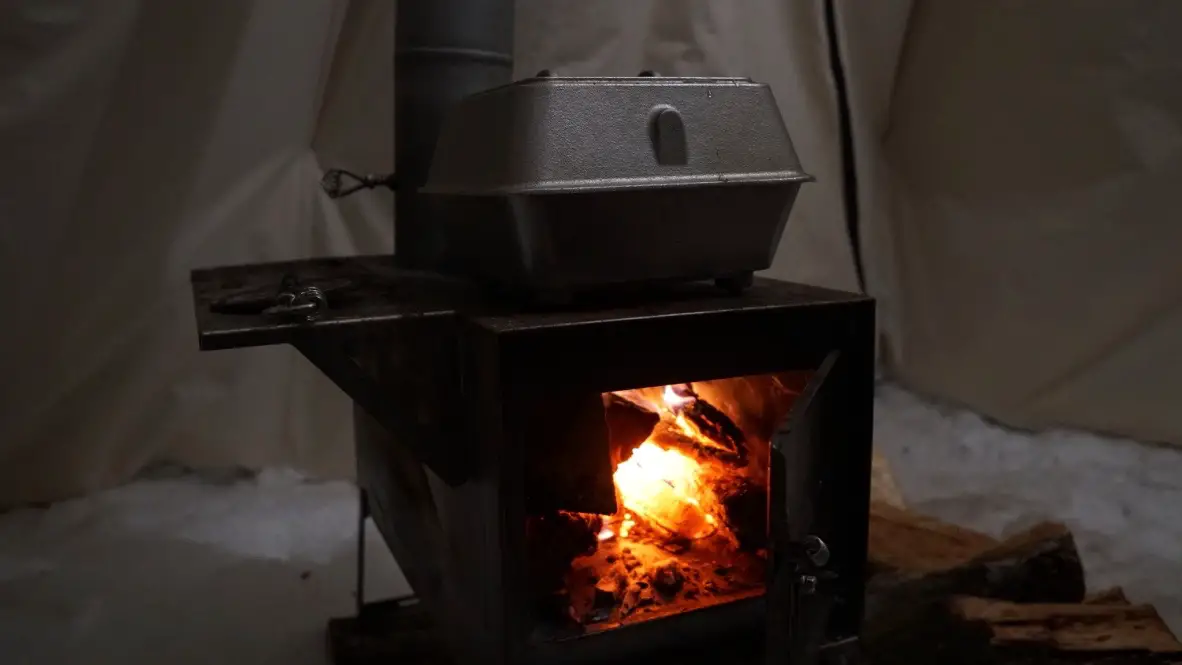One of the best ways to cook a delicious meal while out camping is to use the traditional Dutch Oven. It seems everyone that’s tried it are absolute die-hard fans. However, campers that haven’t cooked a meal with one generally question if it’s worth the weight and bulk.
I generally use my Dutch Oven during winter camping trips. Packing it on the freight toboggan doesn’t seem so bad compared to a canoe pack.
The dutch oven originated in Holland around the early 1700s and has been widely used around the world ever since. George Washington fed his troops with it and Lewis and Clark cooked up horse stew on their historic trek to the west coast. It was used to cook bake beans during the cattle drives and sourdough bread during the Klondike gold rush.
Military camps used it during World War 1 and by the 1970s it had become one of the top choices for campers to cook a meal.
So why the popularity? After all, it’s heavy and bulky. The answer is simple – whatever is cooked in it tastes fantastic, and it cooks just about everything.
The Dutch oven is also called a camp oven, outdoor oven, kitchen oven, and bean pot. The bean pot and kitchen oven are basically the same design, equipped with a rounded lid, flat bottom, and no legs. These are generally used at home and in the oven.
The camp oven and outdoor oven are derived from a different style with a flanged lid, flat bottom with three legs, and a steel bail handle for carrying. This is the style used for camping, with the flanged lid designed for holding hot coals and the legs used to hold the pot above the campfire embers.
Dutch ovens are commonly made from cast iron. The material distributes heat evenly and retains heat, which is why the oven is so effective. The solid lid seals the pot and steams the contents, keeps in the moisture and the food tender. Cast iron is also long-lasting and can literally be passed down from generation to generation.
To cut down in weight, there are aluminum Dutch ovens available. This is definitely an added bonus for anyone wanting to pack it along on an interior trip.
Many traditionalists slam the use of aluminum but the weight difference is significant – cast iron weighs in at 18 pounds and an aluminum model weighs a mere 7 pounds. Aluminum also doesn’t rust and can be washed easily with soap and water. Some models come with a non-stick coating. Aluminum also doesn’t discolor food like cast iron. The pot heats up quickly as well. This can be more of a disadvantage, however. The heat has a tendency to fluctuate too much, making it’s far easier to burn your meal in an aluminum oven than a cast-iron one.
Whichever one you decide to purchase, make sure the lid fits snug to create a good seal but can be moved slightly from side to side. If it’s a cast-iron model, then give it a good wash with soap, water, and scrub brush.

Most cast iron manufacturers place an edible protective wax coating to stop it from rusting during shipment. Right after you wash the Dutch oven, it’s time to season it with vegetable shortening. After this point, soap is never to be used while washing the Dutch oven. The oven must be continually seasoned.
Cast iron is incredibly porous, like a sponge, and the cooking oil fills the fine holes of the stove. Aluminum ovens also benefit from the seasoning process even though aluminum doesn’t rust like iron but it does oxidize and a layer of oil will prevent that from happening.
Rub the shortening on the entire surface area of the cast iron. Then, heat it up in your kitchen oven or your outside barbecue or a campfire.
The seasoning step is a stinky and smoky job (but an important process), so you’re best choosing the outside options. Oil is continually added throughout the use of the oven and eventually, you’ll create a non-stick surface.
I’ve made a lot of stews while out winter camping but this has to be my pride and joy recipe.
Stout Stew
- 4 lbs cubed beef
- 1/2 flour
- 1 tall-can stout Beer (Guinness is good)
- 1/2 cup red wine
- 1 pack Knorr stewing season pack or 1 1/2 cups good beef stock.
- 1 tsp nutmeg
- 1 tsp cracked black pepper
- 2 sprigs chopped fresh rosemary
- 1 tbsp fresh thyme
- 2 cloves chopped garlic
- 2 small red onions, minced
- 2-4 carrots, chopped
- 2-4 parsnip, chopped
- 1 lb turnip, cut in large chunks
- 1 medium pearl onion
- 4-6 baby red potatoes
- salt and pepper
Season beef in salt and pepper, cover in flour, and brown in an oiled skillet. Place cooked beef in Dutch Oven and add the rest of the ingredients, using only a quarter to half the tall-can of the stout. Cook for 2 hours.





